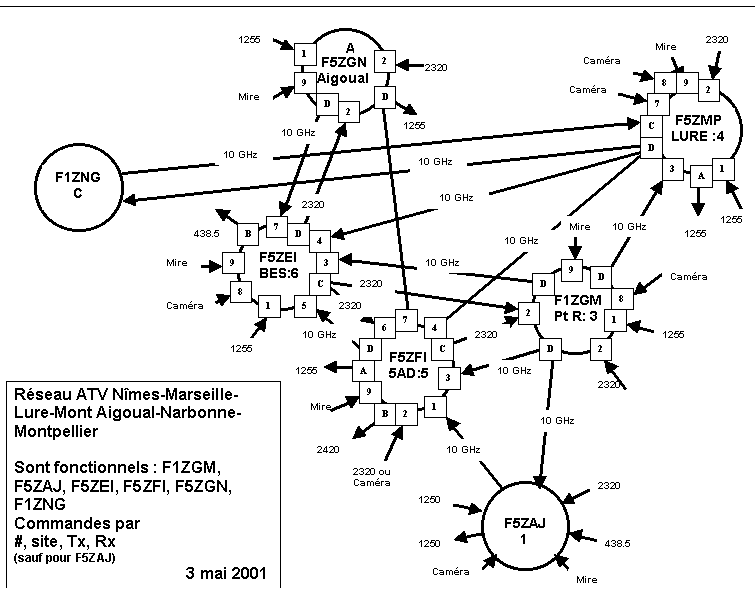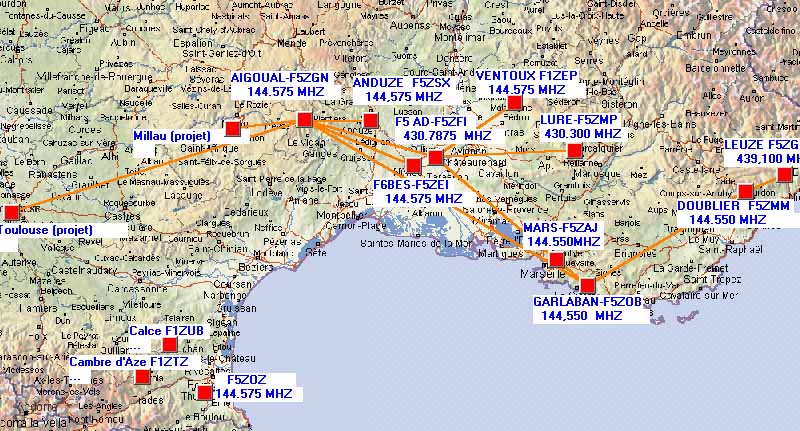
ATV Network
Nimes Marseille Lure Narbonne Aigoual
The local telephony frequencies
Principle of the nodes
Frequencies 438, 1250, 1255, 2320 are user frequencies
Nodes, or repeaters, transmit on 438, 1250, 1255, or 2320 toward the users.
The nodes receive the users on 438, 1250, 1255 or 2320.
Nodes are each others connected a priori on 10 GHz, and in duplex mode ; the transmission can be permanent, with test card in the absence of user.
If the Node receives on the bottom of the band, it transmits on top of the band; if it receives in horizontal polarization, it transmits in vertical polarization.
Some links between nodes can use also the 2300 MHz band ; in this case, the duplex is always possible, but the emission on 2300 is not permanent.
The range of the nodes on the user frequencies (438, 1250,1255, 2320), is a priori local
The user transmits and receives on his local node; the local node connects him to a distant node on which are connected his distant correspondents
The weak range of the nodes on the user frequencies avoids Larsen and allows the duplex
Aigoual an Lure, considering their altitudes derogate a little from this rule.
Remote control of the nodes
The remote control of the nodes :
F1ZGM in Nîmes
F5ZEI by F6BES
F5ZFI by F5AD
and F5ZMP (Lure) built on these principles.
The Aigoual repeater will adopt also this principle if one carries out one day his total recasting.
If other projects wish to use same philosophy, the printed circuit of the remote control will be at their disposal.
Principle of the remote control
The remote control is done in DTMF on VHF or UHF, it comprises four characters which must pass without releasing the PTT and stuck enough the ones to the others (one second maximum between each character).
The first character is a (#)
it is a star (*) for a vocal system
The second character is a figure (zero excluded) or a letter; it corresponds to the geographical situation of node :
The third character corresponds to the frequency on which we want the node to transmit.
It is always a letter: A, B, C, or D
If there is only one frequency used by band, attributions are the following ones:
If there are several transmitters io the same band, one takes the letter of a not used band.
The fourth character corresponds to the source received by the node.
It is always a figure, from 1 to 9.
Figure zero is reserved for the remote controls on/off
For the node, the possible transmitting frequencies are numerous : 438, 1250, 1255, 2300 bottom of band, 2400 top of band, 10 GHz lower band, 10 GHz upper band. There are more sources to be received because it is necessary to add three other sources : a test card, possibly a Web camera filming the site and on certain sites a video input at the disposal of the operator for his maintenance interventions.
Inputs and outputs include video and sub carriers on 6,5 MHz .
The following characters were allocated to these various frequencies or sources :
Restrictions
One cannot use twice the same figure in a group of four, therefore the 5 for example is not available on F5ZFI, since it is already taken for the site character
# is available nowhere since it is useful systematically in first character.
The star is reserved for the telephony sites, like the vocal server
Examples
On site F5ZFI (at F5AD) in Nimes for example, if one wishes to retransmit what is arriving from Marseille to send it to F5ZEI (at F6BES), it is necessary to type
# to announce that an ATV node will be concerned
5 to active node number 5 F5ZFI (F5AD)
D to engage the 10220 transmitter which transmits towards F5ZEI (F6BES)
and 1 to engage the receiver which receives F5ZAJ from Marseille
The complete code is thus #5D1
If it is wanted now that what is coming from Marseille and which is returned towards F5ZEI (F6BES) is diffused at the same time on the area on 438.5, it is moreover necessary to type :
# for ATV node
6 to activate F5ZEI node (F6BES)
B to start it transmitting on 438
And 5 to connect it to the 10220 receiver to receive F5ZFI (F5AD) which is already receiving Marseille.
And so on
A watchdog will stop the nodes after 30 minutes.
Cut of a node
The command is the following one :
# for ATV node
character corresponding to the site
and two zeros
For example #500 will cut F5ZFI node (F5AD), #600 will cut F5ZEI (F6BES).
Simultaneous transmissions
A node can receive only one source at the same time
On the other hand it can transmit on several frequencies at the same time :
For that it is necessary to send it as many groups of command than there will be transmitters in parallel
For example if we wish the tranmissions coming from Marseilles to pass by F5ZFI (F5AD) for being diffused at the same time on Nimes on 1255 and to progress towards F5ZEI (F6BES) on 10220, it is necessary to send the two following codes one after the other by releasing the PTT between the two :
#5A1 then #5D1
At the end of the QSO, the command #500 will cut the two transmitters.
Sub-carriers
There is always a sub-carrier on 6,5 MHz, it retransmits the incident sub-carrier generally the sound channel. With a test card, or a webcam, it may be a local 144 or 432 frequency, or a 1000 Hz note.


Return to the welcome page
© 1999-2011 A. Ducros F5AD